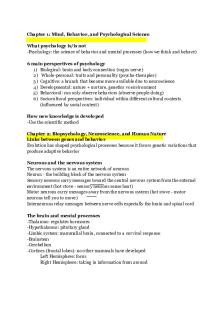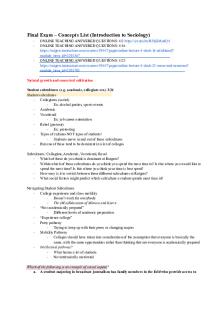Intro to Corrections Ch. 7 Study Guide PDF

| Title | Intro to Corrections Ch. 7 Study Guide |
|---|---|
| Author | Tyrese T. Granger |
| Course | Intro Law Enforcement |
| Institution | Indiana State University |
| Pages | 3 |
| File Size | 65.2 KB |
| File Type | |
| Total Downloads | 54 |
| Total Views | 145 |
Summary
Download Intro to Corrections Ch. 7 Study Guide PDF
Description
CH. 7 STUDY GUIDE The Prison Experience: Males Chapter 7 Entering a prison 1. Total institutions; institutions that control all aspects of those confined there a.) Big House: fortress-like prison emphasizing security and control 2. No frills policy: inmates get bare minimum of food, services, programs, medical care as required by law a. Examples of what inmates lose cable TV, free weights, and education programs. Classification: method of assessing inmate risks and needs that balance the security concerns of the correctional facility with the treatment needs of the inmate. If effective, classification helps ensure a safe environment for both staff and inmates. 1. External Classification System: used to determine level of security needed for incoming prison population 2. Internal Classification System: used to determine the cell and housing assignments as well as facility programs assigned at the prison where the inmate is confined Advantages of classification: -
Reduces institutional tension Improves safety for staff and inmates Avoids placing inmates in more secure and expensive environment than they need Contains gang activity Improves access to services for inmates with special needs.
Difficulties of adjustment: inmates often go through dehumanizing and gradation process upon entering the prison Traditional inmate culture 1. Prisonization: process by which inmates learn and internalize customs and culture of the prison wherein they are confined. 2. Prison culture: values, norms, and attitudes inmates form in order to survive in prison a. Inmate social code: unwritten, informal understanding of how prison works, including how a new inmate adjusts Examples of Inmate Social Code: - don’t interfere w/ inmates’ business -never rat on a con
- don’t exploit fellow inmates - Do your own time - Be tough, be a man, never back down from a fight - don’t trust the ‘hacks’ 3. Deprivation model: model which views losses experienced by the inmate as the cost of imprisonment 4. Importation model: model that suggests that the influences inmates bring with them into the prison affects how they adjust and the process of imprisonment 5. Situational model: model that suggests prison culture is influenced by situations, rather than constants and varies over time and place 6. Administrative control model: management style of prison has influence over what takes place in the inmate culture 7. Prison Argot: a form of slang inmates uses in prison settings to express how they feel a.) Real Men: inmates who endured the rigors of confinement Contemporary inmate issues 1. Prison gangs: a group of inmates who are bonded together by mutual interest. a.) Illegal activities: Illegal sex trade, gambling, and trafficking b.) Prison gangs also called: security threat groups SGT’s c.) Economic victimization: prison gangs often involved in economic victimization d.) Gang violence: high levels of violence if in conflict with other gangs / members of other gangs 2. Prison contraband: unauthorized material processed by prisoners a.) Examples: weapons, clothing (altered) , and drugs . 3. Sex in prison: ranging from consensual to coerced - Typically occurs in three contexts: consensual sex, coercive sexual behavior, and sex for hire 1. Prison Rape Elimination Act: establishes zero tolerance for rape for rape in U.S. prisons. a.) From research, white males with minor drug offenses most likely victimized sexually. 2. Protective custody: designed to keep victims from predators a.) Inmates can check in if they feel they are likely to be sexually assaulted. Expressions of prison violence 1. Prison violence: varies from prison riots, assaults, and self-inflicted violence
a.) Trulson and Marquart found by studying inmate-inmate assault data in Texas prisons that violence was less if inmates were integrated and housed randomly than if they were segregated (p. 171) b.) Inmate balance theory: collective violence occurs when prison officials _______________ in asserting authority. 2. Inmate disturbances: either violent or nonviolent, that brings disruption or even close down the prison a.) Prison riot: collective response of inmates that is violent, in which they strike out against what they consider unfair prison conditions. b.) Riots can include assaults on staff, sit-down strikes, etc. Guarding the prison 1. Custody staff role: dual role to maintain order and support _________________. 2. Correctional officers to be effective need to have ____________________ skills, be able to provide fair___________, and willing to receive updated _________________. 3. Correctional officers of both genders have proven to be a strength in the overall operation of correctional facilities. 4. _______________________________ is an officer positioned along the high wall surrounding the prison 5. Inmates treated fairly and respectfully are _____________likely to become__________than inmates who feel humiliated and abused by staff....
Similar Free PDFs

Intro to sociology ch 1 study guide
- 11 Pages

GEO Ch. 7 Study Guide
- 2 Pages

Intro to Corrections Unit 1 Notes
- 18 Pages

Ch 7 Intro Interpersonal
- 2 Pages

Ch. 7 study guide - Chapter 7
- 4 Pages

Intro to Biology Exam 2 study guide
- 11 Pages

Study Guide Intro to pub Speak
- 8 Pages

Intro to Stats Final Study Guide
- 15 Pages
Popular Institutions
- Tinajero National High School - Annex
- Politeknik Caltex Riau
- Yokohama City University
- SGT University
- University of Al-Qadisiyah
- Divine Word College of Vigan
- Techniek College Rotterdam
- Universidade de Santiago
- Universiti Teknologi MARA Cawangan Johor Kampus Pasir Gudang
- Poltekkes Kemenkes Yogyakarta
- Baguio City National High School
- Colegio san marcos
- preparatoria uno
- Centro de Bachillerato Tecnológico Industrial y de Servicios No. 107
- Dalian Maritime University
- Quang Trung Secondary School
- Colegio Tecnológico en Informática
- Corporación Regional de Educación Superior
- Grupo CEDVA
- Dar Al Uloom University
- Centro de Estudios Preuniversitarios de la Universidad Nacional de Ingeniería
- 上智大学
- Aakash International School, Nuna Majara
- San Felipe Neri Catholic School
- Kang Chiao International School - New Taipei City
- Misamis Occidental National High School
- Institución Educativa Escuela Normal Juan Ladrilleros
- Kolehiyo ng Pantukan
- Batanes State College
- Instituto Continental
- Sekolah Menengah Kejuruan Kesehatan Kaltara (Tarakan)
- Colegio de La Inmaculada Concepcion - Cebu







